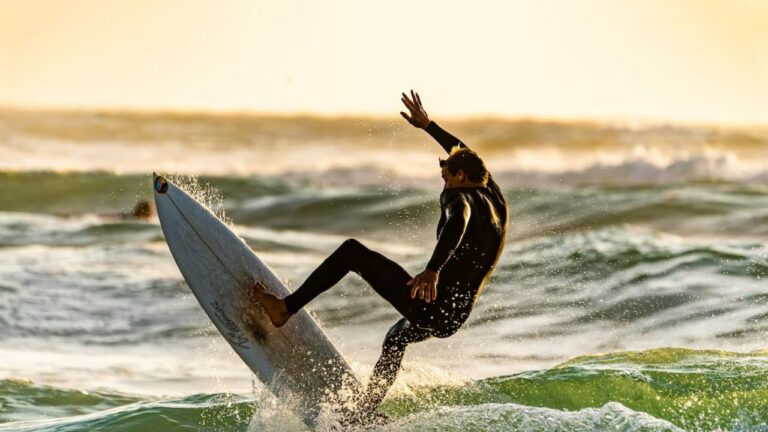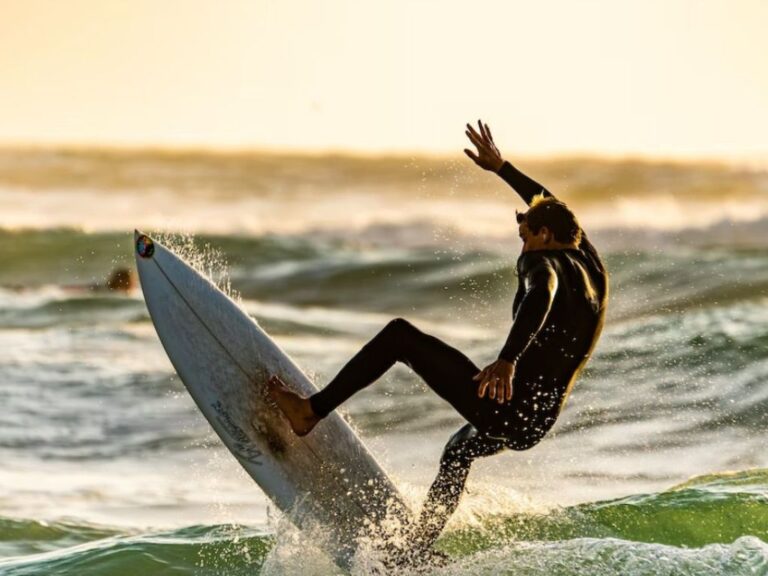There’s no doubt that surfing requires a bunch of physical effort and dedication. And while it’s fun and all, it can also put unwanted strain on your back.
In fact, back pain is a common issue among surfers, and various factors, such as poor technique, muscle imbalance, and impact forces, can cause it. Whether you’re a seasoned pro or a beginner, you must understand the causes and prevention methods for back pain.
According to an old study from 1999 where the researchers looked at surveys from 1,348 surfers that reported acute and chronic injuries, back pain / injuries accounted for a terrifying 16%. If you think that data is old, back strain injuries accounted for 23.3% of the collected data in an Australian study from 2014.
Now that I’ve terrified you enough let’s discuss why this happens. After all, surfers are usually categorized as “healthy and fit individuals.”
How do surfers get back pain / injuries?
1. Poor Technique
If you’re not paddling, standing up, or maneuvering on the board with the correct technique, you’re putting unnecessary strain on your back muscles.
For example, hunching over the board can cause spinal compression and strain the lower back muscles. Similarly, twisting your torso excessively can cause muscle imbalances.
According to a research study from 2012, 38.5% of chronic back issues can be attributed to prolonged paddling and lying on the surfboard.
Solution: Practice and maintain proper posture and form when surfing.
2. Overuse
Repetitive motions can cause muscle fatigue and tightness, pain, and discomfort.
Overuse injuries also occur when you increase the intensity or duration of surf sessions too quickly without giving your body enough time to adapt.
Solution: Gradually increase your surfing activity level. Take frequent breaks to rest and stretch your back muscles.
3. Pre-existing Conditions
Medical conditions, such as herniated discs, sciatica, and spinal stenosis, can also contribute to back pain in surfers.
Talking to your doctor if you have any pre-existing back conditions before you start surfing is crucial.

4. Compression / Impact Force
When paddling out or riding a wave, your body is subjected to powerful pressure that can stress back muscles and joints. These forces can cause muscle strains and spinal compression, leading to pain and discomfort.
Solution: Be mindful and use proper techniques to minimize the impact on your body.
5. Torque / Rotational Force
When twisting and turning on the board, you’re putting much rotational pressure on your back muscles and spine.
Solution: Use proper technique when maneuvering on the board and strengthen your core muscles.
How can surfers manage or prevent back pain?
Back pain is debilitating, and prevention is always better than cure. Take it from me, who has dealt with a herniated disk due to a gym mishap.
Surfers can incorporate several exercises and stretch into their routine to help prevent back pain. These prevention techniques can help you build a strong foundation and reduce the risk of back pain while surfing.
1. Core Strengthening Exercises
Your core muscles stabilize the spine and transfer force from the lower body to the upper body. A strong core can help improve balance and stability, reducing the risk of injury.
Some effective core strengthening exercises include planks, side planks, and bird dogs.
2. Yoga

Yoga is an excellent way to improve flexibility. Surfers can incorporate yoga into their routine to help prevent back pain. As a plus, it can gradually improve your overall surfing game.
Some of the most effective yoga poses for surfers include downward-facing dog, cat-cow stretch, and pigeon pose.
3. Foam Rolling
It’s a self-myofascial release technique that can help reduce muscle tension and improve flexibility.
Foam rolling your muscles can release knots and trigger points that can lead to back pain. It also improves circulation and reduces inflammation, speeding up recovery after surfing sessions.
4. Stretching
Regarding pre-surf warm-up and post-surf cool-down, you gotta bring your A-game. I have known many surfers with impeccable techniques who suffer back pain because of laziness.
“Why didn’t you warm up before?” “I was too excited.”
“Well, why didn’t you cool down after?” “I was too tired.”
Do not do that.
If you’re unsure what to do, I have included my warm-up and cool-down routines at the end of the article.
5. Strengthening Exercises:
You should focus on strengthening the back, hips, and leg muscles to help support the spine and reduce the risk of back pain. Some effective strengthening exercises include the bridge, the glute bridge, and the single-leg deadlift.
What type of back pain do surfers suffer from?
Before we get to the treatments, you must first understand the problem.
Surfing requires paddling, twisting, and turning, which can strain the back muscles and spine. The repetitive nature of these movements can lead to muscle strains, herniated discs, and sciatica, among other types of back pain.
Muscle strain is one of the surfers’ most common types of back pain. Subjecting your body to sudden or excessive forces can result in tears in the muscle fibers.
Another type of back pain that surfers may experience is a herniated disc. This occurs when the soft tissue inside a spinal disc protrudes through a tear in the disc’s outer layer, causing pressure on the nerves that run through the spine.
It might not be as common, but sciatica is also an issue among surfers. This occurs when the sciatic nerve, which runs from the lower back to the feet, becomes compressed or irritated.

What are the treatment options for surfers with back pain?
Various treatment options are available when back pain occurs to help alleviate the symptoms and promote healing.
1. Chiropractic Care
Chiropractors use a hands-on approach to adjust the spine and other joints to help alleviate pain and improve mobility.
This can help relieve pressure on the nerves and reduce inflammation, benefiting surfers who experience back pain due to spinal misalignments or other issues.
2. Physical Therapy
A physical therapist can work with you to develop an individualized treatment plan that may include exercises to strengthen the muscles supporting the spine and manual therapy to help alleviate pain and stiffness.
3. Medication
Over-the-counter pain medication such as ibuprofen or acetaminophen may effectively reduce pain and inflammation associated with back pain. It’s important to note that these medications only provide temporary relief.
4. Injections
Sometimes, injections may be recommended to help manage back pain. Corticosteroid injections can help reduce inflammation and provide temporary pain relief. However, due to potential side effects, these injections are not recommended for long-term use.
5. Surgery
In rare cases, surgery may be necessary to treat back pain that does not respond to other treatments. This is typically reserved for cases with a clear structural problem, such as a herniated disc or spinal stenosis.
Important Note: You should consult a medical professional to determine the best treatment for your body’s needs.
In addition to these treatment options, lifestyle modifications can also play a role in managing back pain in surfers.
Lifestyle Modifications to Prevent Back Pain
If you’re experiencing back pain, it’s important to make lifestyle modifications to help you manage your condition and prevent further injury.
1. Maintain a healthy weight.
It’s the most crucial aspect of reducing the strain on your back. Extra weight can put additional pressure on your spine, exacerbating back pain.
Working on shedding those extra pounds through a healthy diet and regular exercise is important if you’re carrying excess weight.
2. Improve your posture
When you have poor posture, your spine is misaligned, which can cause pressure and strain on your back muscles and nerves.
Make an effort to sit and stand up straight, with your shoulders back and your head in a neutral position. Avoid slouching or hunching over.
3. Get enough rest and sleep.
Rest and sleep are crucial for your body to recover and heal. Ensure you get at least 7-8 hours of sleep each night.
Avoid engaging in strenuous activities or working out too much without giving your body adequate time to rest.

4. Stretch regularly, even when you’re not surfing.
Incorporate stretching into your daily routine, especially before and after surfing sessions. Focus on stretches that target your back muscles, such as spinal twists, cat-cow, and child’s pose.
Pre-surf Warm-up Routine
1. Dynamic Stretching
- Arm circles: Stand with your feet hip-width apart and raise your arms to shoulder height. Move your arms in small circles, gradually increasing the size of the circles. Repeat for 10-15 repetitions.
- Leg swings: Stand with your hands on your hips and swing your right leg forward and backward, keeping your leg straight. Repeat for 10-15 repetitions, then switch to your left leg.
- Torso twists: Stand with your feet shoulder-width apart and rotate your torso from side to side, keeping your arms extended. Repeat for 10-15 repetitions.
2. Mobility Exercises
- Shoulder rotations: Stand with your arms at your sides and raise your arms to shoulder height. Rotate your arms backward in small circles, then forward in small circles. Repeat for 10-15 repetitions.
- Hip circles: Stand with your hands on your hips and rotate your hips in a circular motion, first in one direction and then in the other. Repeat for 10-15 repetitions.
3. Breathing Techniques
Breathing techniques like belly breathing can help you relax and focus before surfing.
Lie on your back with your hands on your belly. Inhale deeply through your nose, filling your belly with air. Exhale slowly through your mouth, pushing all the air out of your belly. Repeat for 10-15 breaths.
VIII. Post-surf Cool-down Routine
A post-surf cool-down routine can help alleviate soreness, increase flexibility, and promote relaxation.
1. Static stretching
Static stretching is a great way to improve flexibility and prevent muscle soreness. Focus on stretching your back, shoulders, hips, and legs. Hold each stretch for at least 30 seconds.
- Seated forward fold: Sit on the ground with your legs straight out before you. Reach forward and try to touch your toes. Hold the stretch for 30 seconds.
- Child’s pose: Kneel on the ground and sit back on your heels. Stretch your arms out before you and rest your forehead on the ground. Hold the stretch for 30 seconds.
- Pigeon pose: Start on all fours and bring your right knee forward so it’s between your hands. Straighten your left leg behind you. Lower your upper body down towards your right leg. Hold the stretch for 30 seconds, then repeat on the other side.
2. Foam Rolling
After a surf session, use a foam roller to target your back, hips, and legs. Roll slowly over each muscle, spending extra time on tight or sore spots.
3. Hot/Cold Therapy
Alternating between hot and cold therapy can help reduce inflammation and promote healing. Take a hot shower or soak in a hot tub for 10-15 minutes, then switch to a cold shower or ice bath for 1-2 minutes.
4. Relaxation Techniques
Stress and tension can contribute to back pain. After a surf session, take some time to relax and unwind. Try deep breathing exercises, meditation, or yoga. You can also try a gentle massage or aromatherapy.
Can your surfboard specs affect back pain?
It might sound cuckoo, but surfboard modifications can be crucial in preventing and alleviating back pain among surfers.

1. Board Volume
If you choose a board with too little volume, you must work harder to maintain stability and generate speed. In contrast, a board with too much volume will be harder to control and maneuver.
Generally, heavier surfers need more volume, while lighter surfers need less. You can use online volume calculators or consult a local surf shop.
2. Board Length & Width
As a beginner, a longer and wider board may suit you, providing more stability and making it easier to catch waves. However, as you gain experience, you should transition to a shorter and narrower board for better performance.
3. Board Shape
Shortboards are more suitable for advanced surfers who want to perform high-speed maneuvers in small to medium waves.
Longboards are more suitable for beginners and intermediate surfers who want to catch small waves and have a stable ride.
Funboards and fish boards are a good middle ground between the two and are suitable for all skill levels.
4. Soft-Top Boards
Finally, consider using a soft-top board if you experience back pain. They’re made with a foam deck that provides a more cushioned ride and minimizes the strain on your back muscles.
Expert QnA
Q. Does surfing compress the spine?
Surfing can compress the spine when you’re paddling or popping up since your lower back is extended and flexed, respectively. Over time, this repetitive compression can lead to back pain and other spinal issues. Proper technique, regular exercise, and proper equipment can minimize the risk.
Q. How can I tell if my back pain is related to surfing?
If you experience pain during or after surfing sessions, your back pain is likely related to surfing. However, seeing a medical professional for an evaluation and proper diagnosis is always a good idea.
Q. Can beginners prevent back pain while learning to surf?
Beginners can prevent back pain by practicing proper technique and gradually building their endurance and strength. Incorporating exercises and stretches into their routine can also help prevent back pain.
Q. Can surfing aggravate pre-existing back conditions?
Surfing can aggravate pre-existing back conditions, so it’s important to consult with a medical professional if you have a history of back pain or injury before starting to surf.




